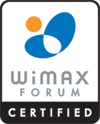
Mobile WiMAX
IEEE 802.16e-2005 contains significant radio improvements over the 802.16d standard that facilitates indoor and mobile access. Mobile WiMAX gets a boost with the unique PacketMAX Solution Architecture that leverages almost a decade of WiMAX R&D; and industry-leading technological innovations at Aperto Labs.
Some of the key benefits derived from Aperto's mobile WiMAX technology are:
1. HIGHER SPECTRAL EFFICIENCY
a. Scalable OFDMA PHY and MAC for optimum channel performance. Scaling of the Fast Fourier Transform (FFT) to the channel bandwidth in order to keep the carrier spacing constant across different channel bandwidths (1.25-20 MHz). Known as Scalable OFDMA, constant carrier spacing results in higher spectrum efficiency in wide channels, and a cost reduction in narrow channels.
2. IMPROVED NLOS COVERAGE
a. Improving non line of sight (NLOS) coverage by utilizing advanced antenna diversity schemes, and hybrid-Automatic Retransmission Request (H-ARQ)
b. Enhanced Fast Fourier Transform algorithm can tolerate larger delay spreads, increasing resistance to multipath interference
3. INCREASED COVERAGE AND CAPACITY (ADAPTIVE MIMO)
a. Using two or more antenna together for multiple transmitting and multiple receiving channels is known as MIMO. Smart MIMO antenna systems switch between spatial diversity (Matrix A) and spatial multiplexing (Matrix B) techniques based on the multi-path conditions to effectively improve both coverage and capacity. At higher SNR, where bandwidth rather than signal strength is limited, MIMO Matrix B outperforms Matrix A in spectral efficiency.
b. MIMO Matrix A (Increase in Coverage)
- i. Downlink STC - This is transmit diversity which makes the downlink more tolerant to fading. It has no impact on channel capacity, other than the fact that the BER may improve thus improving performance.
- ii. Uplink MRC - Base Station uses two antenna to have receive spatial diversity.
c. MIMO Matrix B (Increase in Capacity)
- i. Downlink Spatial Multiplexing (Vertical Encoding) - In this MIMO configuration, the BS will send twice the data in the same amount of time by transmitting two data layers that are vertically encoded.
d. Adaptive Antenna System (AAS) or Beamforming is a form of closed loop MIMO where the base station transmit power modulation relies on channel feedback. The system is useful to get more coverage with fewer cell-sites by concentrating transmit power in narrow beams directed at active subscribers. PacketMAX system roadmap includes support for AAS-capability.
4. INCREASED INDOOR PENETRATION
a. Increasing system gain by use of denser Subchannelization on the uplink, thereby improving indoor penetration
b. Fractional subchannelization reduces co-channel interference at cell edges, allowing the operator to conserve scarce spectrum with frequency reuse of 1
5. ENHANCED VoIP SUPPORT
a. Addition of an extra WiMAX quality of service (QoS) class (enhanced real-time Polling Service) more appropriate for VoIP applications.
6. ENABLING MOBILITY
a. Mobile IP and Handoff Mechanisms for users traveling between sectors
b. Power saving mechanisms for optimal use of personal broadband devices
c. End-to-end Network Reference Model specifying ASN and CSN functions


